|
Return to part one - beginning of article
Personal Interview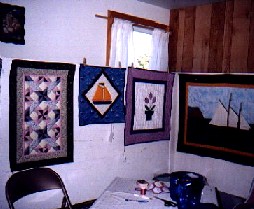
A great deal more can be told about the quilts from Nova Scotia, and I highly
recommend Old Nova Scotian
Quilts
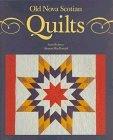 I learned more from
talking with Janet Gordon, a native of NS in her youth who spent much of her
career in Ontario and who returned home again after retirement. She lives near
Hall's Harbour about 60 miles from Halifax on the Bay of Fundy where she has
opened an artist's studio and shop. Janet sells quilts and cross-stitch quilt
labels she makes by hand. Several local artisans use her studio to market their
quilts and hooked rugs.
I learned more from
talking with Janet Gordon, a native of NS in her youth who spent much of her
career in Ontario and who returned home again after retirement. She lives near
Hall's Harbour about 60 miles from Halifax on the Bay of Fundy where she has
opened an artist's studio and shop. Janet sells quilts and cross-stitch quilt
labels she makes by hand. Several local artisans use her studio to market their
quilts and hooked rugs.
Janet's website is http://www.novascotiaquilts.com. I want to thank her for
providing pictures of Nova Scotia and her work to accompany the excerpts I have
gathered from our conversations in the last couple of months.
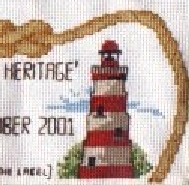 "I only lived in Halifax until 1966 and although I did a little
embroidery - I had been taught that parlour trick at the convent school I went
to as a child - we learned French and embroidered tea towels among other things
- later, I was more concerned with university and having a roaring good time -
not necessarily in that order. Later still, I was busy working and raising kids,
but I did acquire more practical needlework skills like mending and machine
sewing. I didn't return to NS until 1985 and settled where I am now, which is
still a somewhat isolated area, but attractive to tourists." "I only lived in Halifax until 1966 and although I did a little
embroidery - I had been taught that parlour trick at the convent school I went
to as a child - we learned French and embroidered tea towels among other things
- later, I was more concerned with university and having a roaring good time -
not necessarily in that order. Later still, I was busy working and raising kids,
but I did acquire more practical needlework skills like mending and machine
sewing. I didn't return to NS until 1985 and settled where I am now, which is
still a somewhat isolated area, but attractive to tourists."
"As I say, my interest in quilting has only come about over the last 6
or 7 years, so I am probably writing about the area I know best when I set it
right here along this road. 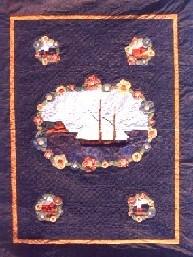
One of my former neighbours, who less than a year ago entered a nursing home
in her late 90's has been one of the foremost primitive rug hooking artists in
Canada. At one time, she and her husband who had a farm and woodlot on a
backroad near here, moved to my present house so that their grandson and a
foster child they were raising could go to school. Just recently in going
through her things, her son has found a small cache of wonderful quilt blocks of
hers which were probably pieced 35 years ago in this house. Another neighbour to
whom the blocks were given, and I plan to set the blocks and complete the quilt
this winter."
"Having been raised in Halifax during the war, I have clear memories of
the shortages and grittiness of a poor province in wartime and on into the 50's.
The age of sail and steamship lines was drawing to a close, and with it easy
communication with the "Boston States".  Other means of travel were
expensive and difficult - roads were mostly unpaved and unimproved, cars were
rare in rural areas, and buses only connected major points. Train travel was at
its zenith, but getting to a train station could present a challenge in many
areas. Other means of travel were
expensive and difficult - roads were mostly unpaved and unimproved, cars were
rare in rural areas, and buses only connected major points. Train travel was at
its zenith, but getting to a train station could present a challenge in many
areas.
--- high tide ---
Women were mostly limited to the radius around their homes that they could
easily travel on foot. For many of them, their sons and husbands were frequently
away for long periods of time, either at sea or in the lumber woods. This put
more of a burden of family work and responsibility on their shoulders, but also
gave them freedom from direction as to what they did with their time! Rural
areas were more heavily populated at that time, so it was common for small
groups of women to meet together.
In this setting, handwork of all sorts continued to flourish and ideas were
freely shared, as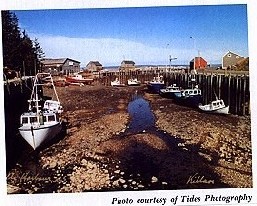 were the occasional new patterns that were gleaned from the
Family Herald, Star Weekly or from the Mountain Mist labels. These patterns were
frequently ones originally published in the Kansas City Star. were the occasional new patterns that were gleaned from the
Family Herald, Star Weekly or from the Mountain Mist labels. These patterns were
frequently ones originally published in the Kansas City Star.
Mainly, then, our local quilts have followed the trends of the rest of North
America, and because we tend to be a conservative bunch here, the patterns have
appeared time and time again.
--- Low tide ---
At the small local quilt show that I co-convene, we have shown Dresden Plate
quilts from the depression, with the soft, sweet pastels against unbleached
muslin; from the fifties (still in the possession of the original quiltmaker) in
eye-popping turkey red and mustard yellow; my daughter's subtle ecru, brown and
gold calico Dresden made for her by my mother in the 70's; and a beautifully
organized scrap Dresden with appliquéd tulip and vine pattern done recently by
the show's co-convener Grace Vaughan, my friend and neighbour.
In rural areas of Nova Scotia, the basic skills and knowledge required for
quiltmaking have never died out. Although quilt guilds have not yet expanded
much beyond the Halifax area, and we are mainly self taught; we have ready
access to all the new tools, books patterns and fabrics, which we use to the
fullest. Many of us, as well, have access to the internet. Our work, however, is
still informed by traditional methods and styles, and by our own particular
characteristics of economy and understatement."
"My father was the only member of his family to emigrate from England
around 1907- so nothing of a household nature came with him as he was a young
bachelor. My mother's mother's household "stuff" was washed away off a
boat landing in Florida - she had just re-married to a strawberry farmer in
Florida - during the 1929 hurricane and only the few items she had left with my
mother survived."
"The only remaining textile I have from my family is two narrow widths
of a cream, handwoven blanket sewn together. This came from my great-grandmother on
my mother's side - she died in her 80's around the time I was born in 1938. It
was spun by her and then woven by her, the wool from sheep on her farm in
Newfoundland - close as I can figure around 1875. It was on my bed as a child as
was a sugar sack spread with butterflies appliquéd on it. I still remember the
texture of both textiles."
Mid-18th Century into the 20th Century
"Americans are not aware that Nova Scotia was the '14th colony' in
British North America, and could have gone with the other 13. Delegates were
sent from here to the early conventions that resulted in the Declaration of
Independence, and there was rebel activity in the NS - NB border area which
resulted in a few hangings and imprisonments. What turned the tide against
rebellion was privateering where an American ship 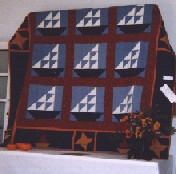 would prey on local ships or
sail into small settlements and take everything that wasn't nailed down - it
wasn't much, but was all the locals had and they didn't take kindly to their
American relatives making off with it! Hall's Harbour which was not settled at
the time was the headquarters for a Captain Hall from the US who made use of
knowledge acquired from local relatives to sail around into Minas Basin and lift
everything he could find. Hall was run off by a group of valley residents who came
overland and surprised him in his winter camp.
would prey on local ships or
sail into small settlements and take everything that wasn't nailed down - it
wasn't much, but was all the locals had and they didn't take kindly to their
American relatives making off with it! Hall's Harbour which was not settled at
the time was the headquarters for a Captain Hall from the US who made use of
knowledge acquired from local relatives to sail around into Minas Basin and lift
everything he could find. Hall was run off by a group of valley residents who came
overland and surprised him in his winter camp.
The expulsion of the Acadians or le grand derangement as it is called in
French had taken place partly because New Englanders wanted to expand settlement
into the cleared and extremely fertile and rich land occupied by the Acadians in
the Annapolis Valley and on huge arable marshes at the Nova Scotia -New
Brunswick border. The wealthy trading and professional class had arrived quickly
in the 1750s from what to this day we call "the Boston States" and
this had cemented the relationships between the Eastern seaboard of the US and
Atlantic Canada. These traders supplied any luxury goods that came into the
province and would act as their customers' personal shopper in Europe and the
Boston States. By 1760 the land was pacified enough to be attractive and safe
for settlement and the work of bringing more land into cultivation."
1908
rural street in Lunenburg, Nova Scotia
1871
city street in Halifax, Nova Scotia
Women's
store window in Halifax - 1871
"My area - the Annapolis Valley - was settled almost exclusively by the
people we call New England Planters, and their names are still recognized today.
My home is on land which was part of an original land grant and the house dates
to early 1820's. The land I'm on is located on the North Mountain near the Bay
of Fundy and would have been woodlot granted in conjunction with farm acreage
and diked land on the valley floor. It would have been settled by 2nd generation
or third generation planters as the farms in the valley became too small to
support everyone. and the younger members had to move out. I do love my old
house, but keeping it warm and in good repair is a trial! It is a classic New
England Cape style house - again a pointer to the New England Planters."
style house - again a pointer to the New England Planters."
"Your next question - where the fabric came from - you're quite right -
New England and Britain. As a matter of fact during the American civil war there
was considerable "looking the other way" and covert assistance to
ships from the south that were trying to run the blockade and continue to supply
the cotton mills of Manchester England. On more than one occasion,
blockade-runners slipped into Halifax Harbour to avoid pursuit from the US Navy,
and slipped out again when the coast was clear."
"We have always raised some sheep in Nova Scotia, but due to predators
such as bobcat, wolf, bear and today feral dogs and coyotes, little large scale
sheep farming exists here. Our spring is late here, too, and makes lambing very
difficult. The exception was an area in the southwest of Nova Scotia where the
micro climate is much more moderate and there are a large number of offshore
islands where larger flocks could be pastured safe from predators and could
derive the dietary benefit of browsing on seaweeds. As a result, a small, but
thriving woolen mill operated at Barrington during the 19th and early 20th
century. It is now part of the Nova Scotia Museum system. In addition, there
were many carding mills in the province, but they were mainly adjuncts of other
mills - flour and/or woodworking and local people brought their wool to have it
carded and then went home to spin it themselves. The resulting fibers were used
for home production of knitted and woven items. There are still several woolen
mills in the maritimes that produce rough heavy knitting yarn in wonderful
colours. This wool is still inexpensive and ubiquitous - one local thrift
department store carries a full range in our nearby town. If anyone wishes to
access this wool, email me and I will forward a URL.
I really don't know much about linen- I know flax was grown, therefore it
must have been used, and most probably as the warp thread in fine woolen cloth
or homespun. Linseed oil was in demand for the manufacture of oilskins."
"As far as I know, there was a large hiatus between farm produced
textiles such as wool and linen, and the manufacture of cotton locally, which
didn't begin until around 1900-1920's and was probably heavy cotton suitable for
bags, clothing protectors and as a basis for oilskins, which were manufactured
here. We were just too close to the cotton mills of New England to need to
develop in that direction. We still, however, have a lively business in
manufacturing Long Johns for obvious reasons."
"During the age of ship building, sailing and coastal trading up and
down the Atlantic seaboard to and from the West Indies was very common. It was
salt cod potatoes and wood down, rum and molasses  and spices back (Nova Scotians
to this day are addicted to ginger - ginger beer, preserved candied ginger,
ginger ice cream, ginger cookies etc etc) with stops along the way to pick up
items family, friends, neighbours and local traders might ask for. My mother had
a little song she used to sing that went: ' Uncle George has gone to town to buy
I some cotton, if he don't get the flowery kind, I hope he brings I nothing.'
She adored 'the flowery kind'." and spices back (Nova Scotians
to this day are addicted to ginger - ginger beer, preserved candied ginger,
ginger ice cream, ginger cookies etc etc) with stops along the way to pick up
items family, friends, neighbours and local traders might ask for. My mother had
a little song she used to sing that went: ' Uncle George has gone to town to buy
I some cotton, if he don't get the flowery kind, I hope he brings I nothing.'
She adored 'the flowery kind'."
When I asked about about quilters in Nova Scotia today, Janet summed it up
nicely:
"We do tend to be an independent lot around here - We have had to
co-operate with one another out of necessity and that has led to a lot of
interesting accommodations. We also tend to be a very inventive and creative
bunch and good at solving problems in unorthodox ways. In rural areas of Nova
Scotia, the basic skills and knowledge required for quiltmaking have never died
out. Quilt guilds have not expanded very far beyond the urban area surrounding
Halifax. We are mainly self-taught; we have ready access to all the new tools,
books, patterns and fabrics, which we use to the fullest. Many of us, as well,
have access to the internet. Our work, however, is still informed by traditional
methods and styles, and by our own particular characteristics of economy and
understatement."
Janet can be found quilting at:
Hall's Harbour Handcrafts and Quilt Studio
Nova Scotia Canada B0P1J0
Janet@novascotiaquilts.com
Http://www.novascotiaquilts.com
Return to beginning of article |